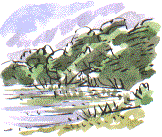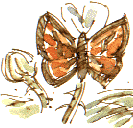 
Empire of the SunSunday 6th August 2000  AN EMPEROR DRAGONFLY, a mature male, glides over a shallow pond near South Elmsall, at the foot of a derelict railway embankment (now restored as a walkway) at the edge of an old colliery site.  The skimmer spends most of its time resting on a sedge, wings outstretched in the characteristic pose for dragonflies (damselflies fold their wings along the length of the body when at rest). We also see Common Darter and Brown Hawker (Aeshna grandis).
The skimmer spends most of its time resting on a sedge, wings outstretched in the characteristic pose for dragonflies (damselflies fold their wings along the length of the body when at rest). We also see Common Darter and Brown Hawker (Aeshna grandis).During the five minutes that I spend watching him, the emperor never touches down. He zips over to the bank to snap a passing white butterfly in mid-air and continues  This water plant is a bit of a mystery. It may be a very eaten-into stem of Amphibious Bistort, although the floating leaves that you'd expect to see around it seem to be absent. This water plant is a bit of a mystery. It may be a very eaten-into stem of Amphibious Bistort, although the floating leaves that you'd expect to see around it seem to be absent.  I'm with the local naturalists' society on the last of our summer field meetings and, as usual, I learn a thing or two. For instance the butterfly I've been thinking of as the Wall Brown recently is, of course, the Gatekeeper (left). I've shown the real wall brown on the right. I think I might have mixed them up in one of my diary entries, I'll have to go back and check.
I'm with the local naturalists' society on the last of our summer field meetings and, as usual, I learn a thing or two. For instance the butterfly I've been thinking of as the Wall Brown recently is, of course, the Gatekeeper (left). I've shown the real wall brown on the right. I think I might have mixed them up in one of my diary entries, I'll have to go back and check.Both species are flying over the wild flowers and grasses of the sunny, sheltered margins of the railway walk. We see a dozen or more gatekeepers but only one wall. My wildlife photographer friend John suggests that the flight 'jiz' of the gatekeeper is that it looks as if someone has it on the end of a piece of cotton and is constantly oscillating it up and down as it flies, so that it makes rather erratic progress. The wall has a more direct flight. The botanically-minded Dorothy and Pauline point out different wild flowers every few yards; Hop Trefoil, Red Bartsia, Centaury and Ribbed Melilot to name just a few. I think of August of being a time when most wild flowers have gone to seed, but it's a good time of year to look at this kind of rough grassy habitat, although the season may be a little bit delayed this year because of the duller cooler weather we've had. You'd think with all the notes I've made in this diary over the past couple of years that I'd be up to speed for local natural history, but when I go out with my naturalist friends I'm reminded of my level of ignorance. There's always something to learn, and there never seems to be enough time in the season to get to grips with it all.
|